Pecharsky V.K., Zavalij P.Y. Fundamentals of Powder Diffraction and Structural Characterization of Materials
Подождите немного. Документ загружается.


Chapter
7
R,
=
16.80%
R,,
=
23.73%
R,
=
13.09%
X2
=64.72
10 20 30 40 50 60
Bragg angle,
28
(deg.)
Figure
7.14. The observed and calculated powder diffraction patterns of CeRhGe3 after
Rietveld refinement of the model in the space group
IWmmm.
Compare with
Figure
7.12.
Hence, this model has no physical and chemical sense because Rh is
indeed present in the material. Finally, all residuals (see Figure
7.14)
are
much higher when compared to those obtained in both the previous
refinement (in the space group I4mm) and Le Bail's full pattern
decomposition (see Table
6.9).
Thus, Rietveld refinement of the model in the
space group symmetry I4lmmm corroborates the conclusion made earlier
about its inadequacy.
7.4.2
Refinement using neutron diffraction data
When we solved this crystal structure using neutron diffraction data, we
found a model (Table
6.28)
where the origin of coordinates was shifted with
respect to that constructed from x-ray diffraction data (Table
6.21
and Table
7.10).
Here, we will first use the coordinates of atoms determined fi-om x-ray
data (this fully refined crystal structure is found in the data file
Ch7Ex03a.inp)
and then perform a refinement of the "original" model as
established fi-om a neutron diffraction experiment (data file
Ch7Ex03b.inp).
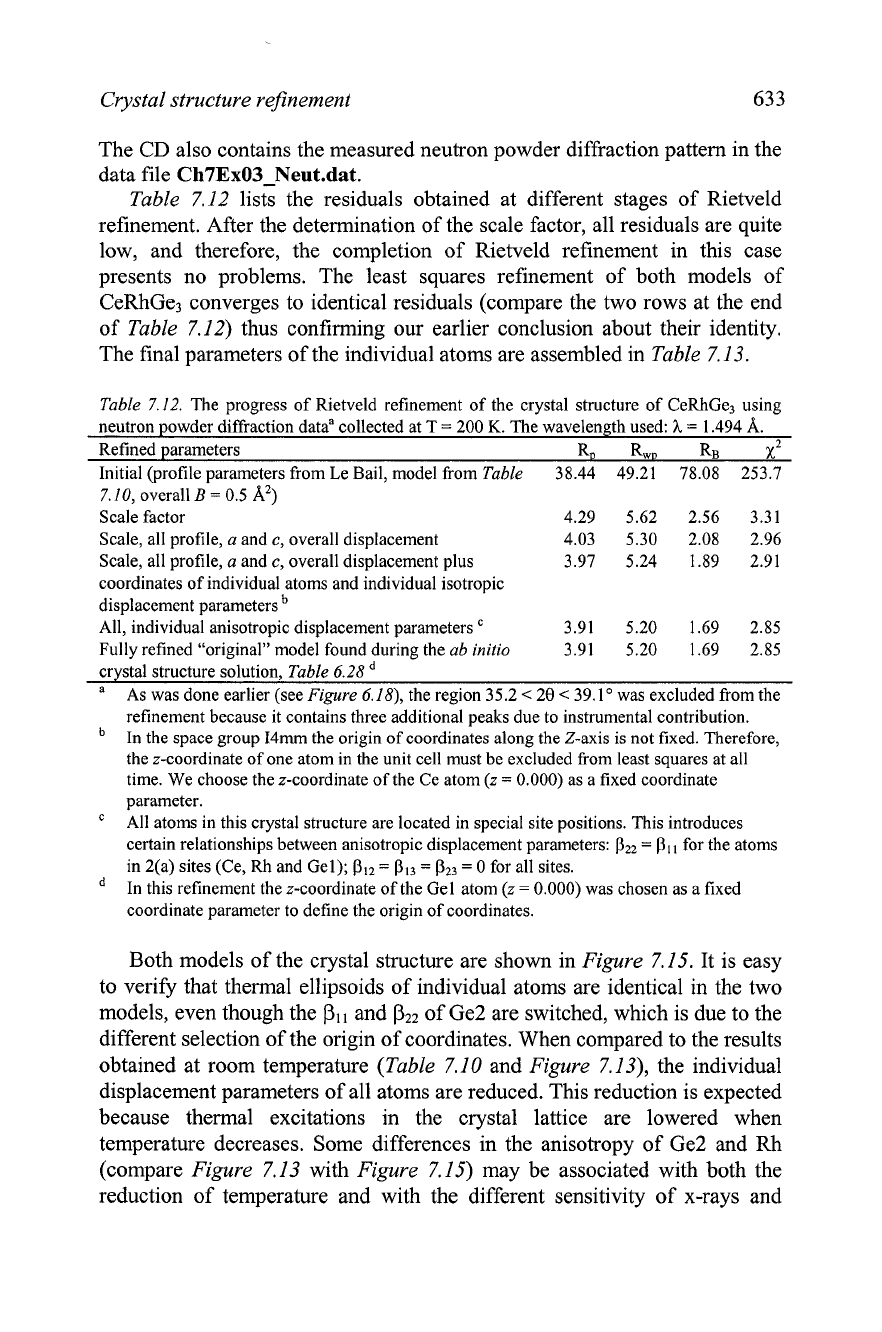
Crystal structure rejnement
633
The CD also contains the measured neutron powder diffraction pattern in the
data file
Ch7Ex03-Neut.dat.
Table
7.12
lists the residuals obtained at different stages of Rietveld
refinement. After the determination of the scale factor, all residuals are quite
low, and therefore, the completion of Rietveld refinement in this case
presents no problems. The least squares refinement of both models of
CeRhGe3 converges to identical residuals (compare the two rows at the end
of
Table
7.12)
thus confirming our earlier conclusion about their identity.
The final parameters of the individual atoms are assembled in
Table
7.13.
Table
7.12.
The progress of Rietveld refinement of the crystal structure of CeRhGe3 using
neutron powder diffraction dataa collected at T
=
200
K.
The wavelength used:
h
=
1.494 A.
Refined parameters
%
RWp
RB
x2
Initial (profile parameters from Le Bail, model from
Table
38.44 49.21 78.08 253.7
7.10,
overall
B
=
0.5 A2)
Scale factor 4.29 5.62 2.56 3.31
Scale, all profile,
a
and
c,
overall displacement 4.03 5.30 2.08 2.96
Scale, all profile,
a
and
c,
overall displacement plus 3.97 5.24 1.89 2.91
coordinates of individual atoms and individual isotropic
displacement parameters
All, individual anisotropic displacement parameters 3.91 5.20 1.69 2.85
Fully refined "original" model found during the
ab initio
3.91 5.20 1.69 2.85
crystal structure solution,
Table
6.28
-
a
As was done earlier (see
Figure
6.18), the region 35.2
<
20
<
39.1 was excluded from the
refinement because it contains three additional peaks due to instrumental contribution.
In the space group I4mm the origin of coordinates along the Z-axis is not fixed. Therefore,
the z-coordinate of one atom in the unit cell must be excluded from least squares at all
time. We choose the z-coordinate of the Ce atom (z
=
0.000) as a fixed coordinate
parameter.
All atoms in this crystal structure are located in special site positions. This introduces
certain relationships between anisotropic displacement parameters:
P22
=
PI
for the atoms
in 2(a) sites (Ce,
Rh
and Gel);
p12
=
PI3
=
P23
=
0 for all sites.
In this refinement the z-coordinate of the Gel atom (z
=
0.000) was chosen as a fixed
coordinate parameter to define the origin of coordinates.
Both models of the crystal structure are shown in
Figure
7.15.
It is easy
to verify that thermal ellipsoids of individual atoms are identical in the two
models, even though the
PI,
and
P22
of Ge2 are switched, which is due to the
different selection of the origin of coordinates. When compared to the results
obtained at room temperature
(Table
7.10
and
Figure
7.13),
the individual
displacement parameters of all atoms are reduced. This reduction is expected
because thermal excitations in the crystal lattice are lowered when
temperature decreases. Some differences in the anisotropy of Ge2 and Rh
(compare
Figure
7.13
with
Figure
7.15)
may be associated with both the
reduction of temperature and with the different sensitivity of x-rays and

634
Chapter
7
neutrons: Ge has the lowest scattering ability for x-rays and it has the largest
coherent scattering length for neutrons.'
Table
7.13.
Structural parameters of CeRhGe3, fully refined by Rietveld technique using
neutron diffraction data. The space group is 14mm. The unit cell dimensions are:
a
=
4.39180(4),
c
=
10.0238(1)
A.
Some of the anisotropic displacement parameters are fixed by
symmetry:
PI1
=
(jI3
=
P23
=
0. All sites are fully occupied.
Atom Site
x
Y
z
l~~xp,, lo4x~,, 104xp3,
Model 1
Ce
2(a) 0 0 O.OOOOa 57(5) 57(5) lO(2)
Rh 2(a) 0 0 0.6598(3) 53(6) 53(6) 3(1)
Ge
1
2(a) 0 0 0.4219(3) 43(4) 43(4) 12(1)
Ge2 4(b) 1 I2 0 0.2630(3) 74(5) 41(4) 7(1)
Model 2
Ce 2(a) 0 0 0.7630(3) 57(5) 57(5) lO(2)
Rh 2(a) 0 0 0.1033(2) 53(6) 53(6) 3(1)
Ge 1 2(a) 0 0 0.3412(2) 43(4) 43(4) 12(1)
Ge2 4(b) 112 0 O.OOOOa 41(4) 74(5) 7(1)
a
This coordinate was fixed to determine the origin of coordinates.
Figure
7.15.
The two models of the crystal structure of CeRhGe3 refined using neuii-on
powder diffraction data collected at T
=
200
K.
The thermal displacement ellipsoids are
shown at
99%
probability. See
Figure
6.20
and relevant discussion explaining the choice of
the origin of coordinates in the two drawings.
'
Anisotropic parameters obtained employing neutron data, where scattering occurs on
nuclei, are more reliable because in the x-ray diffraction, the anisotropy reflects stronger
and potentially improperly accounted
absorptionlporosity effects in addition to a
deformation of the electron density. Overall, atomic anisotropy obtained from powder
diffraction data should be carefully analyzed, especially if preferred orientation is present.
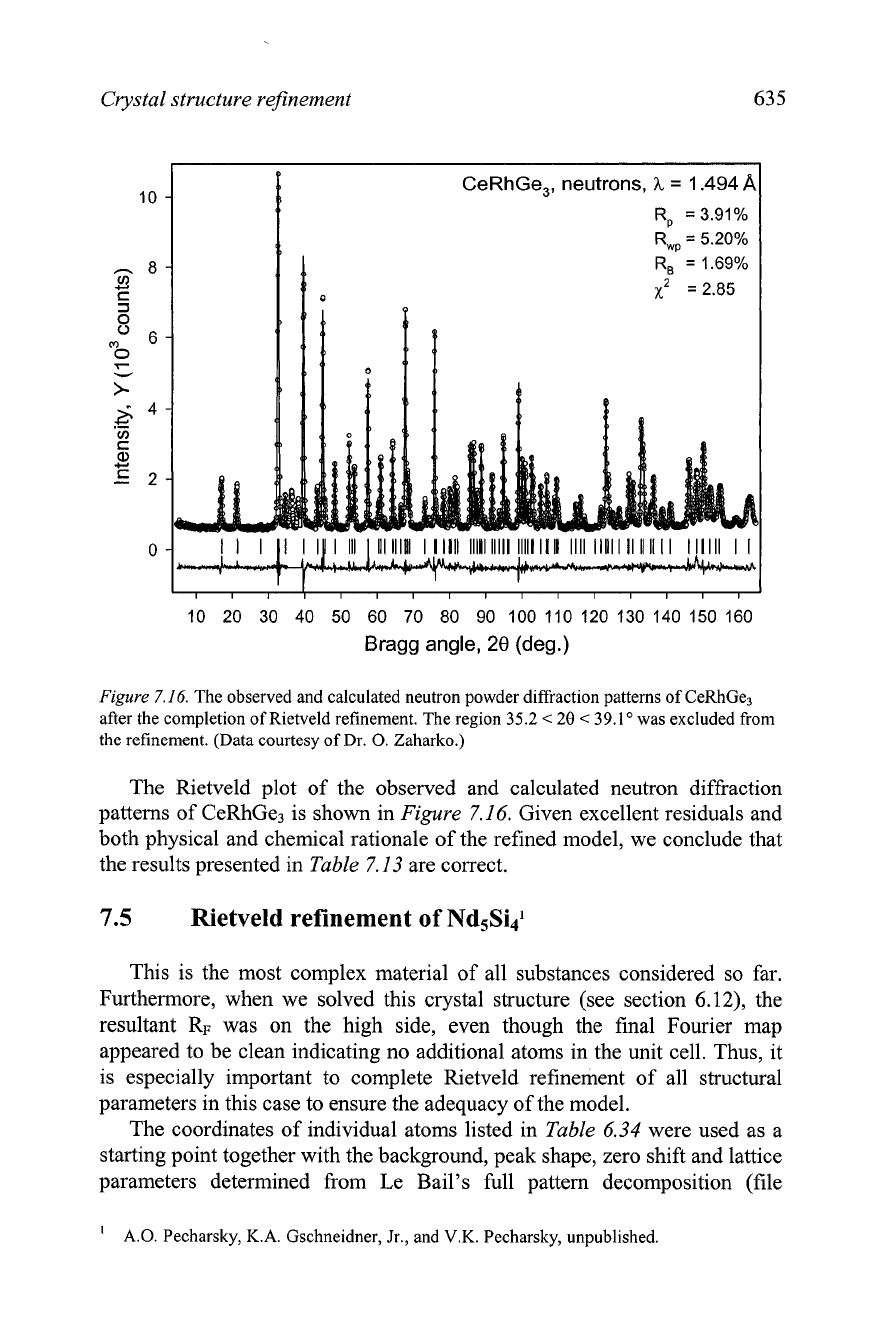
Crystal structure rejnernent
63
5
CeRhGe,, neutrons,
h
=
1.494
A
R,
=
3.91%
R,,
=
5.20%
11111111l111111l
10 20 30 40 50 60 70 80 90 100 110 120 130 140 150 160
Bragg angle,
20
(deg.)
Figure
7.16.
The observed and calculated neutron powder diffraction patterns of CeRhGe3
after the completion of Rietveld refinement. The region 35.2
<
28
<
39.
lo
was excluded from
the
refinement. (Data courtesy of Dr.
0.
Zaharko.)
The Rietveld plot of the observed and calculated neutron diffraction
patterns of CeRhGe3 is shown in
Figure
7.16.
Given excellent residuals and
both physical and chemical rationale of the refined model, we conclude that
the results presented in
Table
7.13
are correct.
7.5
Rietveld refinement
of
Nd5Si41
This is the most complex material of all substances considered so far.
Furthermore, when we solved this crystal structure (see section 6.12), the
resultant
RF
was on the high side, even though the final Fourier map
appeared to be clean indicating no additional atoms in the unit cell. Thus, it
is especially important to complete Rietveld refinement of all structural
parameters in this case to ensure the adequacy of the model.
The coordinates of individual atoms listed in
Table
6.34
were used as a
starting point together with the background, peak shape, zero shift and lattice
parameters determined from Le Bail's full pattern decomposition (file
A.O.
Pecharsky,
K.A.
Gschneidner, Jr., and
V.K.
Pecharsky, unpublished.

63 6
Chapter
7
Ch7Ex04a.inp
is found on the
CD
together with the experimental data,
Ch7Ex04-CuKa.dat).
The progress of the Rietveld refinement is illustrated
in
Table
7.14.
Table
7.14.
The progress of Rietveld refinement of the crystal structure of Nd5Si4 using x-ray
powder diffraction data. Wavelengths used:
hKa,
=
1.54059
A,
hKa2
=
1.54441
A.
Refined parameters
RD
RWP
RB
x2
Initial (profile parameters from Le Bail, model from lxloS lxlo5 lxlo4 6~10~
Table
6.34,
overall
B
=
0.5
A2)
Scale factor 10.17 13.09 7.64 7.95
Scale, all profile,
a
and
c,
overall
B
9.46 12.23 6.57 6.97
Scale, all profile,
a
and
c,
overall
B
plus coordinates of 7.12 9.23 4.04 3.98
individual atoms
a
All above plus preferred orientation, [001] 7.04 9.18 3.89 3.93
All, plus individual isotropic displacement parameters of 7.01 9.12 3.68 3.89
Nd only (both Si atoms were constrained to have the
same isotropic
B)
All, plus individual anisotropic displacement parameters 6.92 9.01 3.52 3.80
of ~d,~ both Si atoms were constrained to have the same
isntrnnir
R
.--,.
-
r'-
.-
"he
coordinates of Nd3 in the 4(a) site are constrained by syninictry:
y
=
x.
The individual anisotropic parameters of Nd3 in 4(a) site are constrained by symmetry:
P22=
P11;
023
=-
P13.
The initial model of the crystal structure results in acceptable residuals
without refinement of coordinates and displacement parameters of individual
atoms. When the coordinates of all atoms and the overall displacement
parameter were included into the least squares, the residuals further improve
(row four in
Table
7.14).
The biggest improvement is observed in the Bragg
residual,
RB,
which is expected because this figure of merit is mostly
affected by the adequacy of the structural model and it is least affected by
the inaccuracies in profile parameters.
Unlike in any of the examples considered earlier, a small preferred
orientation contribution is evident in this powder diffraction pattern after
including a relevant parameter (Eq. 2.79) into the refinement, as seen in row
5
in
Table
7.14.
An
important issue to consider when refining preferred
orientation is the direction of the texture axis. When the preferred orientation
effects are strong, axis direction is usually easy to recognize from a simple
analysis of the relationships between the observed and calculated intensities
of groups of Bragg reflections with related indices. For example, if most or
all Bragg reflections with indices (001) have observed intensities much
stronger (or weaker) than calculated, this suggests that the preferred
orientation axis is
[OOl] or [110], respectively, depending on the type of
texture (see sections 2.10.6 and 3.5.2). When the preferred orientation effects
are small, the only feasible way to determine the direction of the preferred
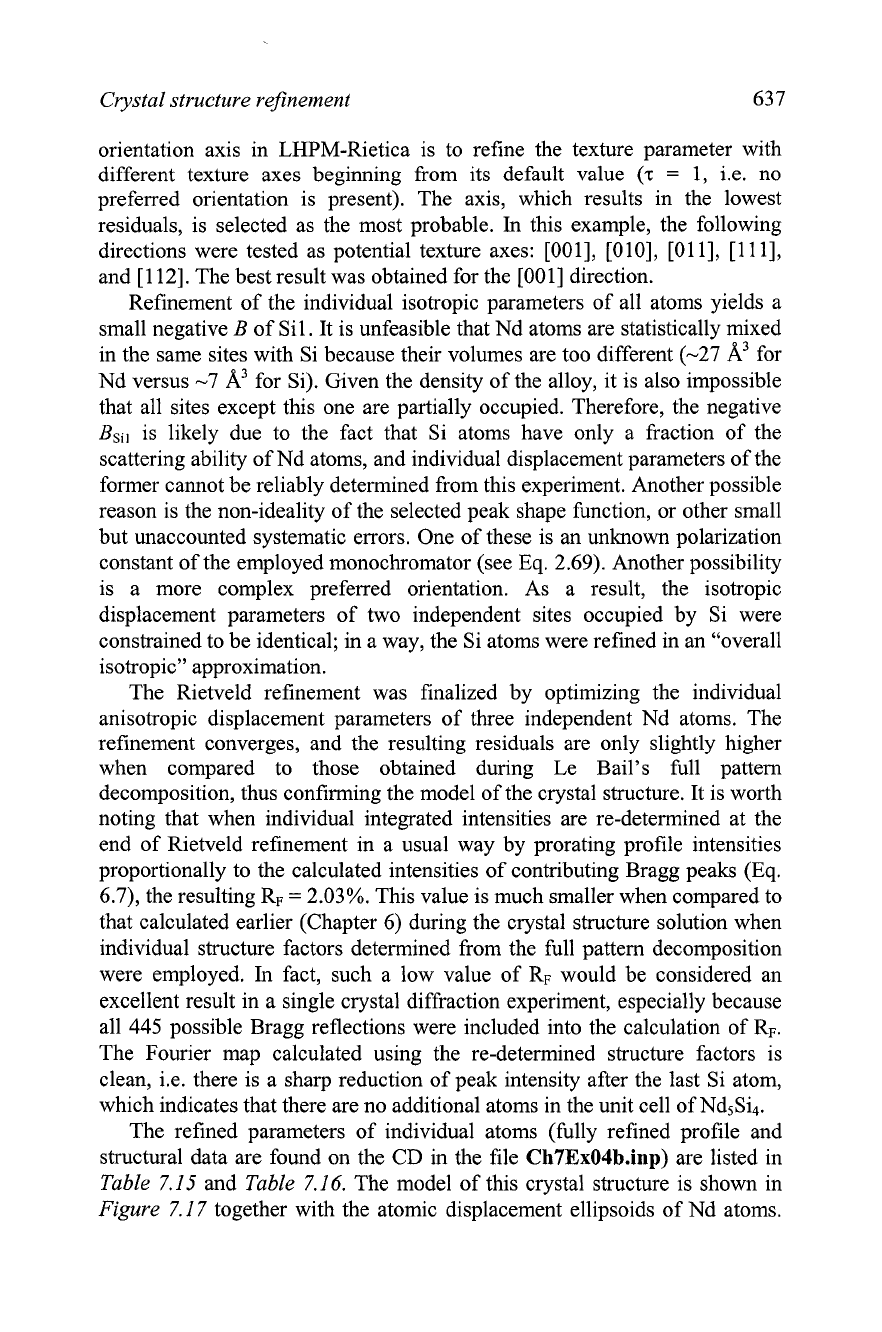
Crystal structure rejkement 63 7
orientation axis in LHPM-Rietica is to refine the texture parameter with
different texture axes beginning from its default value
(z
=
1,
i.e. no
preferred orientation is present). The axis, which results in the lowest
residuals, is selected as the most probable.
In
this example, the following
directions were tested as potential texture axes: [OOl], [OlO], [Oll], [Ill],
and [112]. The best result was obtained for the [OO 11 direction.
Refinement of the individual isotropic parameters of all atoms yields a
small negative
B
of Sil. It is unfeasible that Nd atoms are statistically mixed
in the same sites with Si because their volumes are too different (-27
W3
for
Nd versus
-7
A3
for Si). Given the density of the alloy, it is also impossible
that all sites except this one are partially occupied. Therefore, the negative
Bsil
is likely due to the fact that Si atoms have only a fraction of the
scattering ability of Nd atoms, and individual displacement parameters of the
former cannot be reliably determined from this experiment. Another possible
reason is the non-ideality of the selected peak shape function, or other small
but unaccounted systematic errors. One of these is an unknown polarization
constant of the employed monochromator (see Eq. 2.69). Another possibility
is a more complex preferred orientation. As a result, the isotropic
displacement parameters of two independent sites occupied by Si were
constrained to be identical; in a way, the Si atoms were refined in an "overall
isotropic" approximation.
The Rietveld refinement was finalized by optimizing the individual
anisotropic displacement parameters of three independent Nd atoms. The
refinement converges, and the resulting residuals are only slightly higher
when compared to those obtained during Le Bail's full pattern
decomposition, thus confirming the model of the crystal structure. It is worth
noting that when individual integrated intensities are re-determined at the
end of Rietveld refinement in a usual way by prorating profile intensities
proportionally to the calculated intensities of contributing Bragg peaks (Eq.
6.7), the resulting RF
=
2.03%. This value is much smaller when compared to
that calculated earlier (Chapter 6) during the crystal structure solution when
individual structure factors determined from the full pattern decomposition
were employed.
In
fact, such a low value of RF would be considered an
excellent result in a single crystal diffraction experiment, especially because
all
445
possible Bragg reflections were included into the calculation of RF.
The Fourier map calculated using the re-determined structure factors is
clean, i.e. there is a sharp reduction of peak intensity after the last Si atom,
which indicates that there are no additional atoms in the unit cell of Nd5Si4.
The refined parameters of individual atoms (fully refined profile and
structural data are found on the
CD
in the file
Ch7Ex04b.inp)
are listed in
Table
7.15
and Table
7.16.
The model of this crystal structure is shown in
Figure
7.1 7
together with the atomic displacement ellipsoids of Nd atoms.
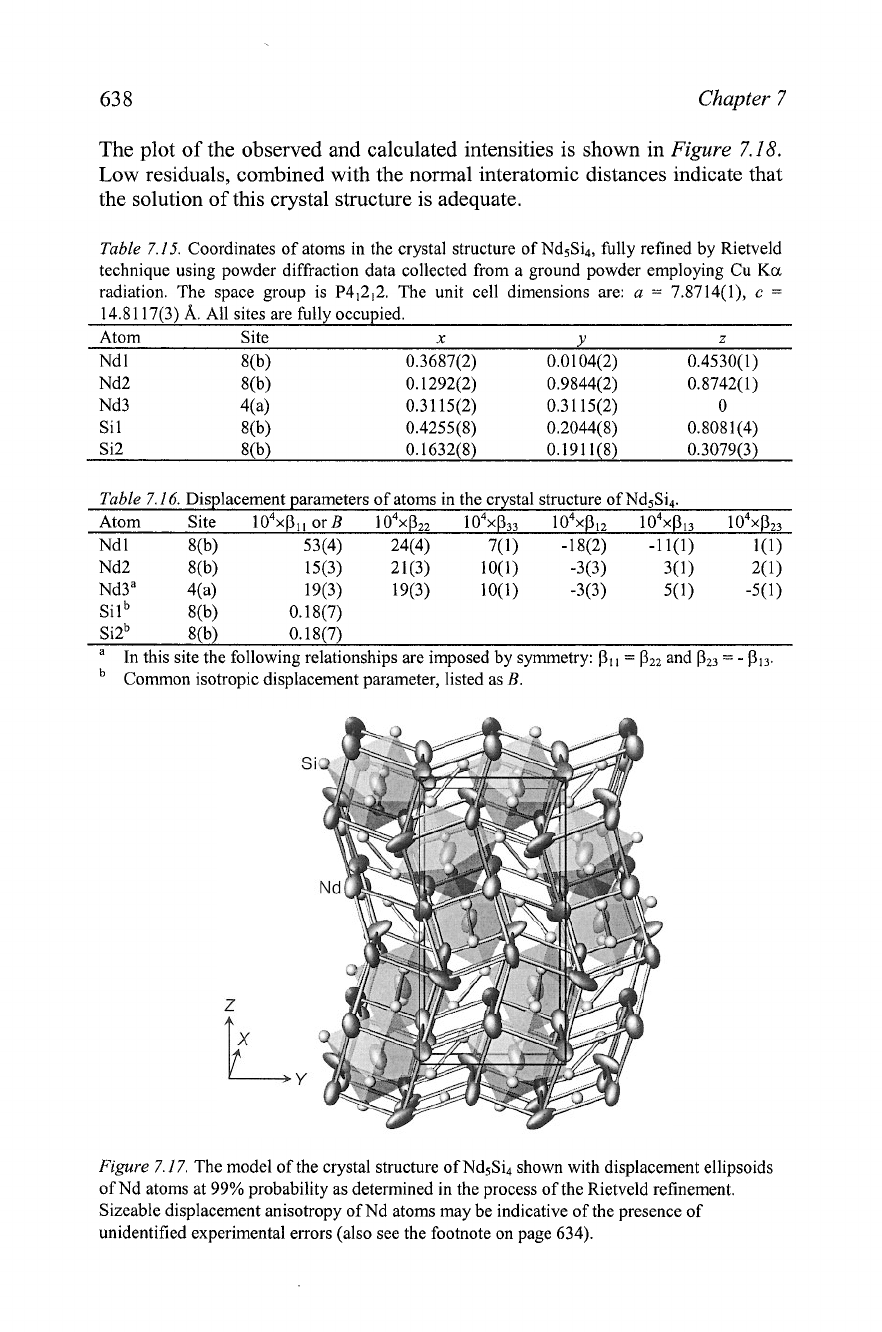
63
8
Chapter
7
The plot of the observed and calculated intensities is shown in
Figure
7.18.
Low residuals, combined with the normal interatomic distances indicate that
the solution of this crystal structure is adequate.
Table
7.15.
Coordinates of atoms in the crystal structure of Nd5Si4, fully refined by Rietveld
technique using powder diffraction data collected from a ground powder employing Cu
Ka
radiation. The space group is P41212. The unit cell dimensions are:
a
=
7.8714(1),
c
=
1
Atom
Site
x
Y
z
Nd 1
8(b) 0.3687(2)
0.01 04(2) 0.4530(1)
Nd2
8@) 0.1292(2) 0.9844(2)
0.8742(1)
Nd3 4(a) 0.31 15(2)
0.31 15(2) 0
Si 1 8(b) 0.4255(8) 0.2044(8) 0.8081(4)
Si2 8(b) 0.1632(8)
0.1911(8) 0.3079(3)
Table
7.16.
Displacement parameters of atoms in the crystal structure of Nd5Si4.
Atom Site 10~xp,, or
B
10~x~,, 104~j333 1o4xPI3 1o4xPZ3
Nd 1 8(b) 53(4) 24(4) 7(1) -18(2) -11(1) 1(1)
Nd2 8(b) 15(3) 21(3) lO(1) -3(3) 3(1) 2(1)
Nd3a 4(a) 19(3) 19(3) lO(1) -3(3) 5(1)
silb 8(b) 0.18(7)
~i2~ 8(b) 0.18(7)
a
In this site the following relationships are imposed by symmetry:
PI1
=
PZ2
and
P23
=
-
PI3.
Common isotropic displacement parameter, listed as
B.
Figure
7.17.
The model of the crystal structure of Nd5Si4 shown with displacement ellipsoids
of Nd atoms at 99% probability as determined in the process of the Rietveld refinement.
Sizeable displacement anisotropy of Nd atoms may be indicative of the presence of
unidentified experimental errors (also see the footnote on page 634).
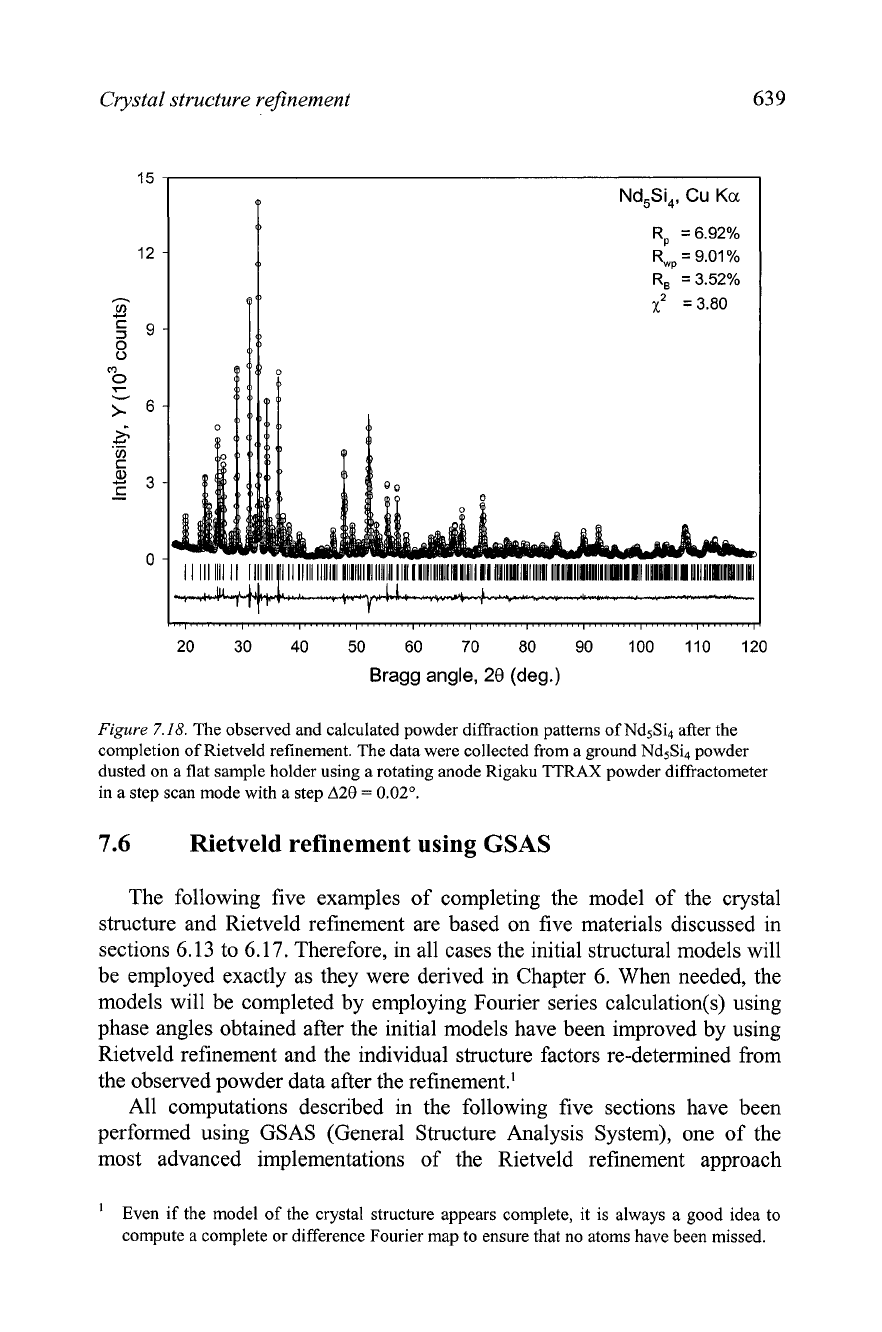
Crystal structure reJinement
63
9
R,
=
6.92%
R,,
=
9.01
%
R,
=
3.52%
X2
=3.80
20 30 40 50 60 70 80 90 100 110 120
Bragg angle,
28
(deg.)
Figure
7.18.
The observed and calculated powder diffraction patterns of Nd,Si4 after the
completion of Rietveld refinement. The data were collected from a ground Nd5Si4 powder
dusted on a flat sample holder using a rotating anode Rigaku
TTRAX powder diffractometer
in a step scan mode with a step
A29
=
0.02'.
7.6
Rietveld refinement using
GSAS
The following five examples of completing the model of the crystal
structure and Rietveld refinement are based on five materials discussed in
sections 6.13 to 6.17. Therefore, in all cases the initial structural models will
be employed exactly as they were derived in Chapter 6. When needed, the
models will be completed by employing Fourier series calculation(s) using
phase angles obtained after the initial models have been improved by using
Rietveld refinement and the individual structure factors re-determined from
the observed powder data after the refinement.'
All computations described in the following five sections have been
performed using GSAS (General Structure Analysis System), one of the
most advanced implementations of the Rietveld refinement approach
'
Even if the model of the crystal structure appears complete, it is always a good idea to
compute a complete or difference Fourier map to ensure that no atoms have been missed.
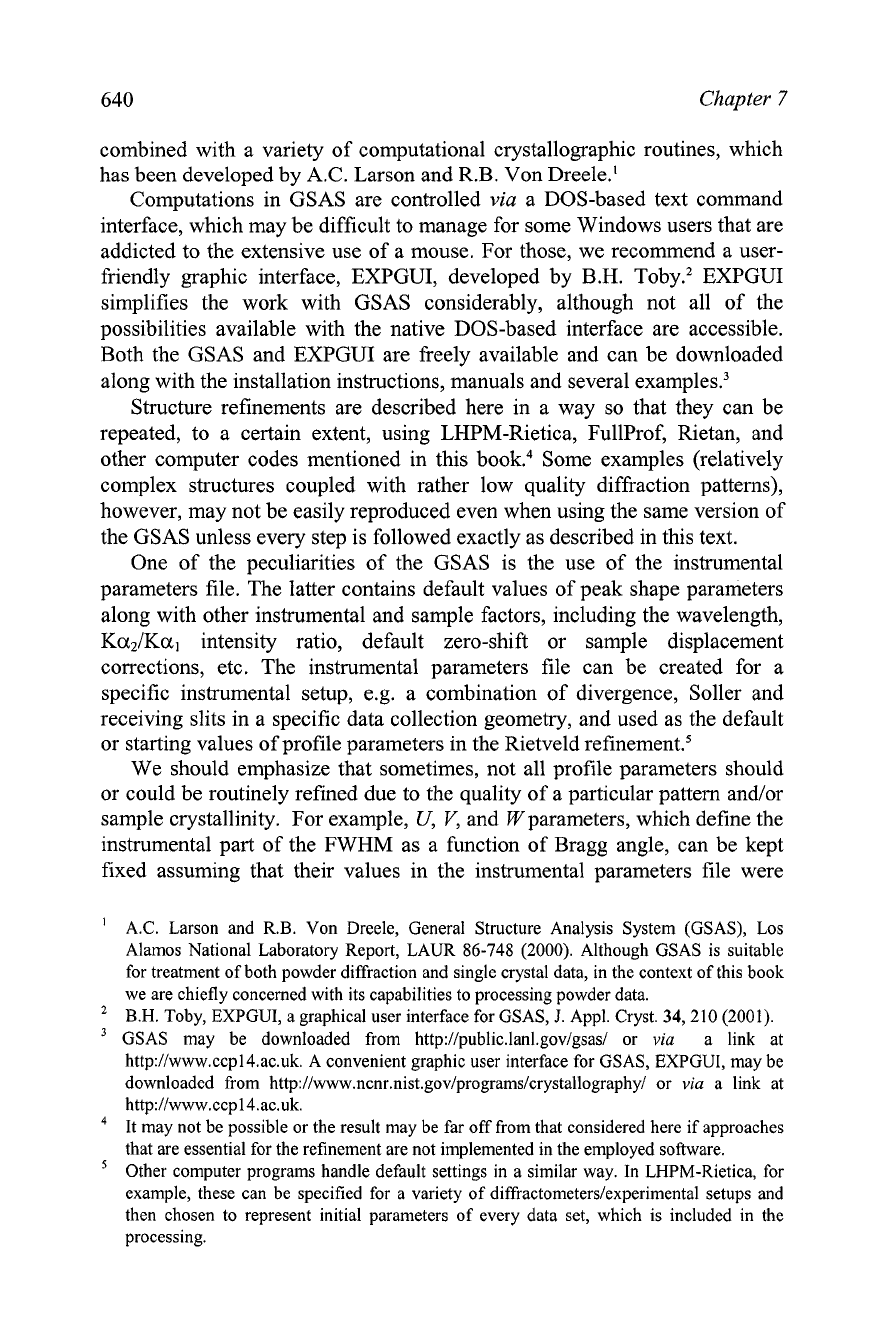
640
Chapter
7
combined with a variety of computational crystallographic routines, which
has been developed by A.C. Larson and R.B. Von Dreele.'
Computations in GSAS are controlled
via
a DOS-based text command
interface, which may be difficult to manage for some Windows users that are
addicted to the extensive use of a mouse. For those, we recommend a user-
friendly graphic interface, EXPGUI, developed by B.H.
Toby.2 EXPGUI
simplifies the work with GSAS considerably, although not all of the
possibilities available with the native DOS-based interface are accessible.
Both the GSAS and EXPGUI are freely available and can be downloaded
along with the installation instructions, manuals and several
example^.^
Structure refinements are described here in a way so that they can be
repeated, to a certain extent, using LHPM-Rietica, Fullprof, Rietan, and
other computer codes mentioned in this book.4 Some examples (relatively
complex structures coupled with rather low quality diffraction patterns),
however, may not be easily reproduced even when using the same version of
the GSAS unless every step is followed exactly as described in this text.
One of the peculiarities of the GSAS is the use of the instrumental
parameters file. The latter contains default values of peak shape parameters
along with other instrumental and sample factors, including the wavelength,
Ka21Kal
intensity ratio, default zero-shift or sample displacement
corrections, etc. The instrumental parameters file can be created for a
specific instrumental setup,
e.g. a combination of divergence, Soller and
receiving slits in a specific data collection geometry, and used as the default
or starting values of profile parameters in the Rietveld refi~~ernent.~
We should emphasize that sometimes, not all profile parameters should
or could be routinely refined due to the quality of a particular pattern and/or
sample crystallinity. For example,
U,
V,
and Wparameters, which define the
instrumental part of the FWHM as a function of Bragg angle, can be kept
fixed assuming that their values in the instrumental parameters file were
A.C. Larson and R.B. Von Dreele, General Structure Analysis System (GSAS), Los
Alamos National Laboratory Report, LAUR 86-748 (2000). Although GSAS is suitable
for treatment of both powder diffraction and single crystal data, in the context of this book
we are chiefly concerned with its capabilities to processing powder data.
B.H.
Toby, EXPGUI, a graphical user interface for GSAS,
J.
Appl. Cryst. 34,210 (2001).
GSAS may be downloaded from
http://public.lanl.gov/gsas/
or
via
a link at
http:Nwww.ccpl4.ac.uk. A convenient graphic user interface for GSAS, EXPGUI, may be
downloaded from
http://www.ncnr.nist.gov/programs/crystallography/
or
via
a link at
http://www.ccpl4.ac.uk.
It may not be possible or the result may be far off from that considered here if approaches
that are essential for the refinement are not implemented in the employed software.
Other computer programs handle default settings in a similar way. In LHPM-Rietica, for
example, these can be specified for a variety of
diffractometers/experimental
setups and
then chosen to represent initial parameters of every data set, which is included in the
processing.
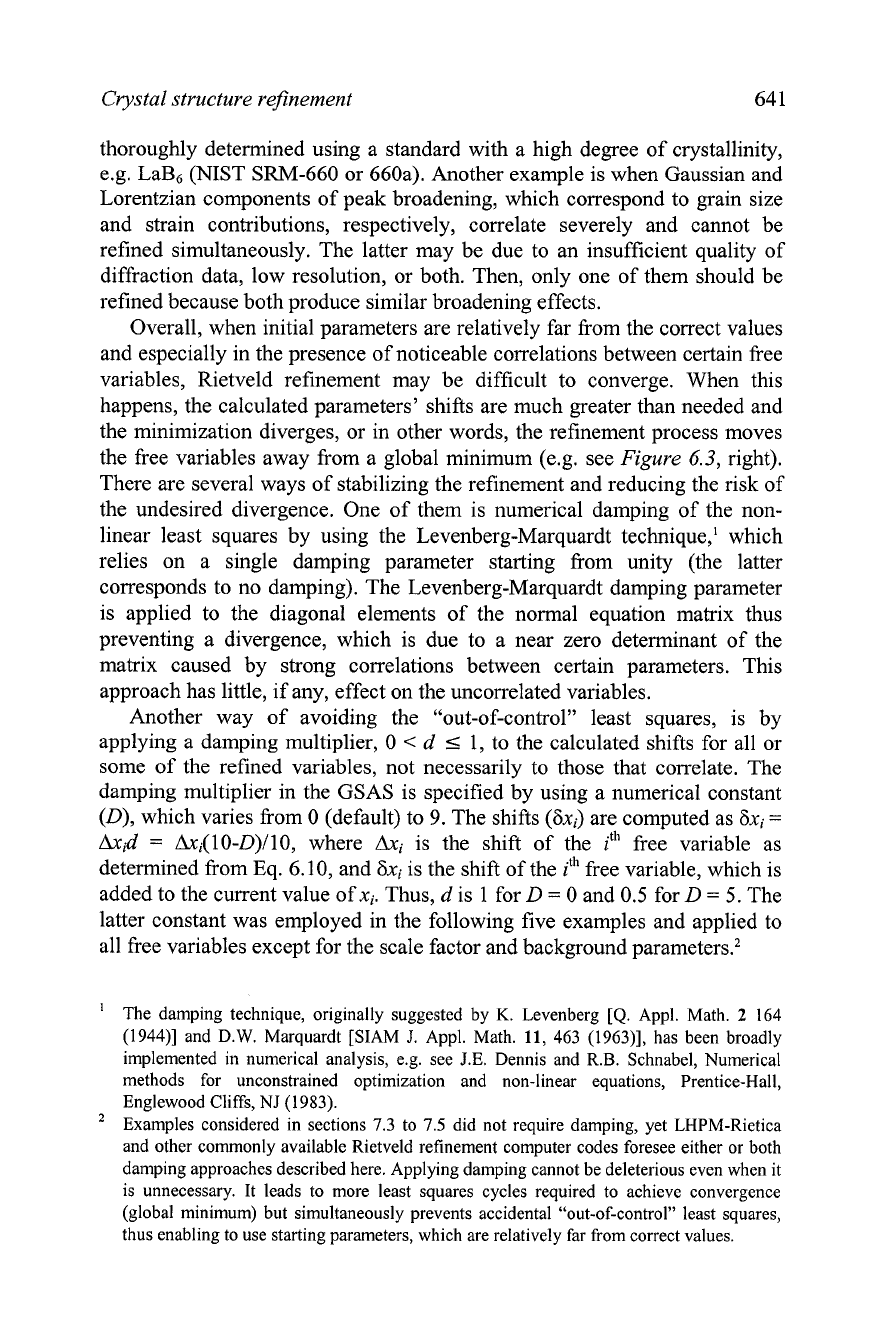
Crystal
structure refinement
64
1
thoroughly determined using a standard with a high degree of crystallinity,
e.g. La& (NIST SRM-660 or 660a). Another example is when Gaussian and
Lorentzian components of peak broadening, which correspond to grain size
and strain contributions, respectively, correlate severely and cannot be
refined simultaneously. The latter may be due to an insufficient quality of
diffraction data, low resolution, or both. Then, only one of them should be
refined because both produce similar broadening effects.
Overall, when initial parameters are relatively far from the correct values
and especially in the presence of noticeable correlations between certain free
variables, Rietveld refinement may be difficult to converge. When this
happens, the calculated parameters' shifts are much greater than needed and
the minimization diverges, or in other words, the refinement process moves
the free variables away from a global minimum
(e.g. see
Figure
6.3,
right).
There are several ways of stabilizing the refinement and reducing the risk of
the undesired divergence. One of them is numerical damping of the non-
linear least squares by using the Levenberg-Marquardt technique,' which
relies on a single damping parameter starting from unity (the latter
corresponds to no damping). The Levenberg-Marquardt damping parameter
is applied to the diagonal elements of the normal equation matrix thus
preventing a divergence, which is due to a near zero determinant of the
matrix caused by strong correlations between certain parameters. This
approach has little, if any, effect on the uncorrelated variables.
Another way of avoiding the "out-of-control" least squares, is by
applying a damping multiplier,
0
<
d
I
1, to the calculated shifts for all or
some of the refined variables, not necessarily to those that correlate. The
damping multiplier in the GSAS is specified by using a numerical constant
(D), which varies from 0 (default) to
9.
The shifts (6xi) are computed as 6xi
=
Axid
=
Axi(lO-D)/10, where
Axi
is the shift of the
ith
free variable as
determined from Eq. 6.10, and 6xi is the shift of the
ith
free variable, which is
added to the current value of xi. Thus,
d
is 1 for
D
=
0
and 0.5 for D
=
5. The
latter constant was employed in the following five examples and applied to
all free variables except for the scale factor and background
parametem2
The damping technique, originally suggested by
K.
Levenberg
[Q.
Appl. Math.
2
164
(1944)l and D.W. Marquardt [SIAM
J.
Appl. Math.
11,
463 (1963)], has been broadly
implemented in numerical analysis, e.g. see
J.E.
Dennis and R.B. Schnabel, Numerical
methods for unconstrained optimization and non-linear equations, Prentice-Hall,
Englewood Cliffs,
NJ
(1983).
Examples considered in sections 7.3 to 7.5 did not require damping, yet LHPM-Rietica
and other commonly available Rietveld refinement computer codes foresee either or both
damping approaches described here. Applying damping cannot be deleterious even when it
is unnecessary. It leads to more least squares cycles required to achieve convergence
(global minimum) but simultaneously prevents accidental "out-of-control" least squares,
thus enabling to use starting parameters, which are relatively far from correct values.
